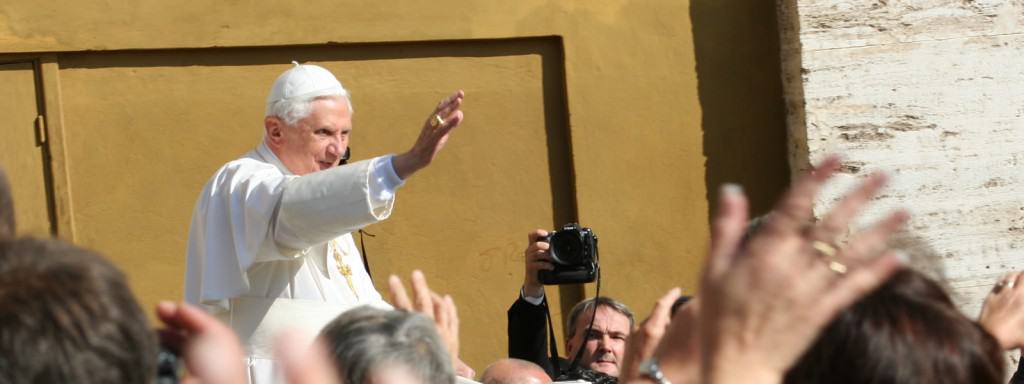Matthew’s gospel ends with Jesus saying: “I am with you always until the end of the world” (28:20b). The apostles believed that the risen Lord would never leave them without guidance. The Church was to be indestructible because Jesus said to Peter:
“Upon this rock I shall build my Church. The gates of hell shall not prevail against it” (Mt. 16:18).
This promise was based on the indefectibilty of the Church as a whole. No single member, not even the pope, as a private person, has such a guarantee of holiness or adherence to the true faith.
The Church is a mixture of saints and sinners. In the Nicene Creed we state our belief that the Church is one, holy, catholic, and apostolic. However the Vatican II council stated “that on the earth the Church is marked with a genuine though imperfect holiness.” How then, was Jesus’ promise of his presence and guidance fulfilled?
Jesus as a Teacher and a Servant
Jesus who chose the twelve displayed his authority from the beginning of his ministry. “He taught with authority, not like their scribes” (Mt. 7:29; Mk. 1:22).
He had the authority to forgive sins (Mt. 9:6-8; Mk. 2:5-10). Jesus is portrayed as the “Lord of the sabbath” (Mk. 2:23-28). He conquers the forces of evil (Mk. 1:27).
His sovereign power is revealed in these words: “Full authority has been given me both in heaven and earth” (Mt.28:18).
However Jesus rebuked his disciples when they sought positions of honor in their group implying that they must be like him. “The Son of Man has not come to be served, but to serve – to give his life in ransom for the many” (Mk. 10:36-45).
Jesus in his apostolic discourse gave the twelve authority to go out and preach the gospel (Mt.10). “Cure the sick, raise the dead, heal the lepers, expel demons” (10:8).
He gave them authority to absolve sin: “If you forgive men’s sins they are forgiven them” (Jn.20:21).
However the Church is not only hierarchical it has “apostles, prophets, evangelists, pastors, and teachers in roles of service for the faithful to build up the body of Christ” (Eph. 4:11; 1 Cor. 12: 27-31). They have their vocation of contributing to the teaching ministry of the Church. This was graphically illustrated by bishops at the Vatican II Council bringing with them periti, experts in their respective fields of learning, to advise them in the deliberations taking place.
The Petrine Chair
Peter’s role of leadership is clear that he is the spokesman (Mk. 8:29; Mt. 18:21; Lk. 12:41; Jn. 6:67-69).
In the four lists of the apostles he is always first (Mk. 3:16-19; Mt. 10:1-4; Lk. 6:12-16; Acts 1:13). Paul in the earliest account of the resurrection writes “that he was seen first by Cephas,” (1 Cor. 15:5).
However three special texts bring out Peter’s unique role. One, Jesus gives Simon a new symbolic name, Petros (Kephas {Aramaic} = Rock). He is to be the rock foundation of the Church and to have the chief rabbi’s prerogative of “binding and loosing.”
Two, after a quarrel among the twelve over the ambition of some, Jesus gave Peter a special duty. “I have prayed for you that your faith may never fail. You in turn must strengthen your brothers” (Lk.22:32).
The last text is from John where Jesus is seen as the good shepherd (Jn. 10). Later Jesus passes on his role to Peter of tending the sheep (Jn. 21:15-19). He also reveals Peter’s martyrdom. In Acts Peter is clearly in the role of leadership (Ch.1-10).
Peter’s presence in Rome is well attested to (1 Pt. 5:13). Peter because of his role in Jerusalem continued to be a leader in Rome.
Peter and Paul died as martyrs during the Neronian persecution (60’s). The third bishop from the apostles, Clement, writes that a disagreement arose in the Corinthian Church and how he arbitrated a solution.
Ignatius wrote that the “Roman Church is the president of love. It teaches others but does not itself receive instruction.”
Tertullian and Hyppolytus in the early second century regarded Peter as the first in the line of bishops of Rome. Cyprian saw the unity of the Church as founded on Peter when Peter moved to Rome the Church also settled there.
Ambrose said “where Peter is, there is the Church.”
Augustine in dealing with Pelagianism sought the support of the Apostolic See’s condemnation to give credibility to the African bishops’ verdict. The trajectory of Peter’s primacy can be clearly traced in the NT and is further supported by the Church fathers.
For the early fathers the identity of the oral tradition with the original revelation is guaranteed by the unbroken succession of bishops in the great sees going back lineally to the apostles.
The Catechism of the Catholic Church states that the Roman Pontiff, head of the college of bishops, enjoys infallibility in virtue of his office, when as supreme pastor and teacher of all the faithful – who confirms his brethren in the faith – he proclaims by a definitive act a doctrine pertaining to faith and morals.
This infallibility is also present in the body of bishops when together with Peter’s successor they exercise the supreme magisterium in an ecumenical council (891 A.D.)
Vatican II stated that infallibility must be related to the faith of the whole Church, that there must be collegial cooperation between the pope and the bishops (Church III.22). It also states: “the whole body of faithful who have an anointing from the Holy One cannot err in matters of belief.” They too, have “a share in Christ’s prophetic office” (II.12).
As a closing, you can get quotations from popes here.
